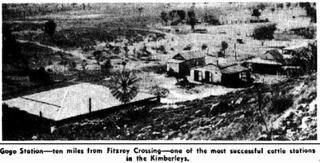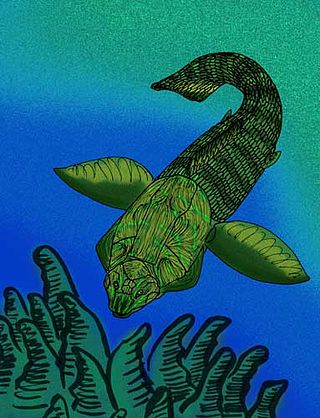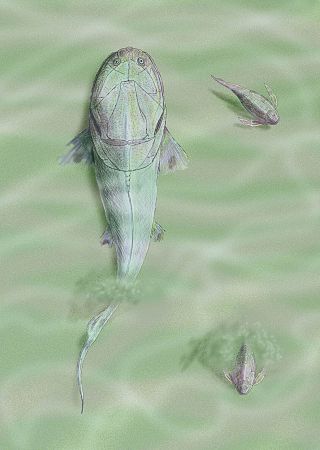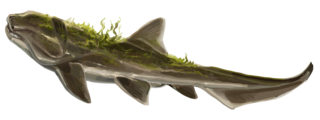
Placodermi is a class of armoured prehistoric fish, known from fossils, which lived from the Silurian to the end of the Devonian period. Their head and thorax were covered by articulated armoured plates and the rest of the body was scaled or naked, depending on the species. Placoderms were among the first jawed fish; their jaws likely evolved from the first of their gill arches.

Arthrodira is an order of extinct armored, jawed fishes of the class Placodermi that flourished in the Devonian period before their sudden extinction, surviving for about 50 million years and penetrating most marine ecological niches. Arthrodires were the largest and most diverse of all groups of Placoderms.

Groenlandaspis is an extinct genus of arthrodire from the Late Devonian. Fossils of the different species are found in late Devonian strata in all continents except eastern Asia. The generic name commemorates the fact that the first specimens of the type species were found in Greenland.

Coccosteus is an extinct genus of arthrodire placoderm from the Devonian period. Its fossils have been found throughout Europe and North America. The majority of these have been found in freshwater sediments, though such a large range suggests that they may have been able to enter saltwater. It was a small placoderm, with Coccosteus cuspidatus measuring 29.6–43.9 cm (11.7–17.3 in) long.

Titanichthys is an extinct genus of giant, aberrant marine placoderm from shallow seas of the Late Devonian of Morocco, Eastern North America, and possibly Europe. Many of the species approached Dunkleosteus in size and build. Unlike its relative, however, the various species of Titanichthys had small, ineffective-looking mouth-plates that lacked a sharp cutting edge. It is assumed that Titanichthys was a filter feeder that used its capacious mouth to swallow or inhale schools of small, anchovy-like fish, or possibly krill-like zooplankton, and that the mouth-plates retained the prey while allowing the water to escape as it closed its mouth. A study has since confirmed this assumption as its jaws are functionally closer to that of filter feeders like baleen whales and basking sharks, and it appears to have developed from benthic durophagists that became pelagic suspension feeders. This would make it the first (known) large-sized vertebrate filter feeder. Titanichthys was estimated to have reached a length of 7–7.5 m (23–25 ft), but Engelman (2023) suggested that Titanichthys was comparable in size to Dunkleosteus, likely measuring about or just over 4.1 metres (13 ft) in length.

Brindabellaspis stensioi is a placoderm with a flat, platypus-like snout from the Early Devonian of the Taemas-Wee Jasper reef in Australia. When it was first discovered in 1980, it was originally regarded as a Weejasperaspid acanthothoracid due to anatomical similarities with the other species found at the reef.

Lunaspis is an extinct genus of armor-plated petalichthyid placoderm fish that lived in shallow marine environments of the Early Devonian period, from approximately 409.1 to 402.5 million year ago. Fossils have been found in Germany, China and Australia. There are three different identified species of within the genus Lunaspis: L. broilii, L. heroldi, and L. prumiensis.

The Gogo Formation in the Kimberley region of Western Australia is a Lagerstätte that exhibits exceptional preservation of a Devonian reef community. The formation is named after Gogo Station, a cattle station where outcrops appear and fossils are often collected from, as is nearby Fossil Downs Station.

Holonema is an extinct genus of relatively large, barrel-shaped arthrodire placoderms that were found in oceans throughout the world from the Mid to Late Devonian, when the last species perished in the Frasnian-Fammian extinction event. Most species of the genus are known from fragments of their armor, but the Gogo Reef species, H. westolli, is known from whole, articulated specimens. Holonema is thought to have been a benthic-dwelling fish, based on its cambered body shape, which performs better hydrodynamically when closer to the sea bed. According to these specimens, species of Holonema lived by grazing on stony, horn-shaped, stromatolite-like algae called oncholite, apparently by snipping off the points with a specialized snout.

Incisoscutum is an extinct genus of arthrodire placoderm from the Early Frasnian Gogo Reef, from Late Devonian Australia. The genus contains two species I. ritchiei, named after Alex Ritchie, a palaeoichthyologist and senior fellow of the Australian Museum, and I. sarahae, named after Sarah Long, daughter of its discoverer and describer, John A. Long.
Ligulalepis is an extinct genus of prehistoric bony fish. Ligulalepis was first described from isolated scales found in the Taemas-Wee jasper limestones of New South Wales by Dr Hans-Peter Schultze (1968) and further material described by Burrow (1994). A nearly complete skull found in the same general location was described in Nature by Basden et al. (2000) claiming the genus was closely related to basal ray-finned fishes (Actinopterygii). In 2015 Flinders University student Benedict King found a more complete new skull of this genus which was formally described by Clement et al. (2018), showing the fish to be on the stem of all osteichthyans.
Erromenosteus is a genus of extinct, medium-sized brachythoracid arthrodire placoderm from the Late Frasnian of the Kellwasserkalk facies of Late Devonian Bad Wildungen and Bicken, Germany.

Holonematidae is an extinct family of relatively large arthrodire placoderms from the Early to Late Devonian. Almost all fossil specimens are of armor fragments, though, all have distinctive ornamentation, often of unique arrangements and patterns of tubercles, that are diagnostic of the family. The trunkshield is very elongated, giving the armor an overall "barrel" like appearance.

Protitanichthys is an extinct genus of comparatively large coccosteid arthrodire placoderms from the Middle Devonian of the eastern United States. Fossils are found primarily in the Eifelian-epoch aged Delaware Limestone of Ohio, and the Lower Givetian-aged Rockport Quarry Limestone of Michigan

Homostiidae is a family of flattened arthrodire placoderms from the Early to Middle Devonian. Fossils appear in various strata in Europe, Russia, Morocco, Australia, Canada and Greenland.

Errolosteus goodradigbeensis is an extinct buchanosteid arthrodire placoderm. Its fossils have been found in Emsian-aged marine strata of New South Wales, Australia.

Heterosteus is an extinct genus of heterosteid placoderm of the Middle Devonian known from remains discovered in Europe and Greenland. According to Denison, 1978, Heterosteus might have been planktivorous, along with Homosteus, and Titanichthys.

Millerosteus is an extinct genus of coccosteid arthrodire placoderm from the Early Givetian stage of the Middle Devonian period. Fossils are found in the Orkneys and Caithness, Scotland. It was a small placoderm with an body length of 14 cm (5.5 in). Millerosteus is one of the few arthrodires known from specimens preserving the entire skeleton.

Tityosteus is an extinct genus of homostiid arthrodire from the Early Emsian of the Early Devonian, with fossils known from Germany, the Ibero-Armorican Trough, and southern Siberia. It attained a length of 2.5 meters.
Cathlesichthys is an extinct genus of homostiid arthrodire from Wee Jasper, during the Early Devonian.
























